
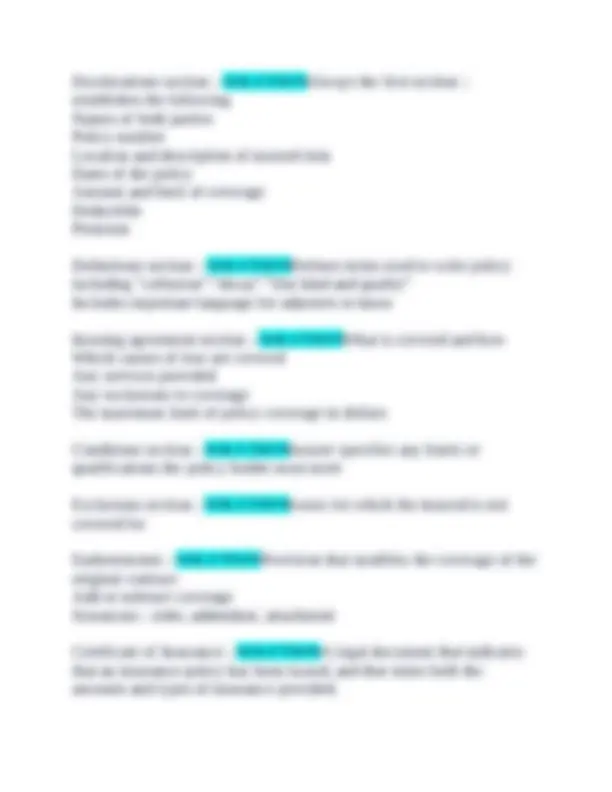
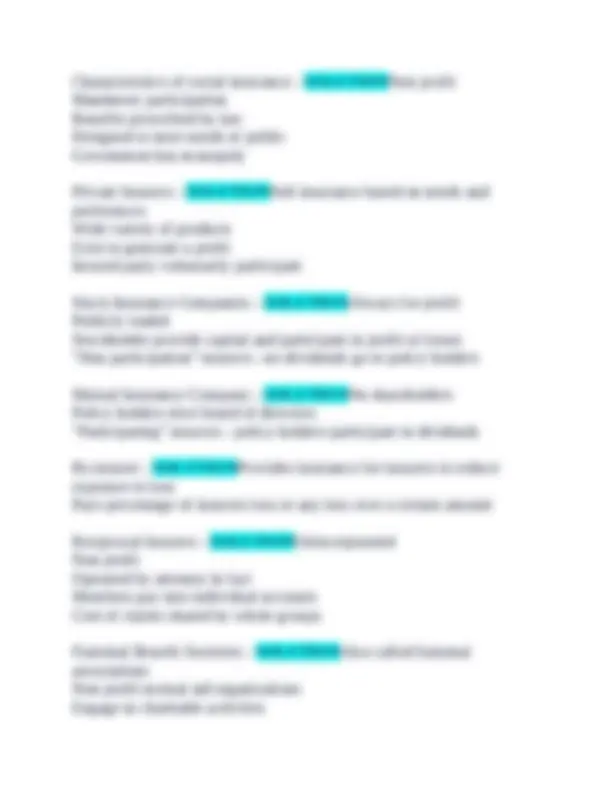
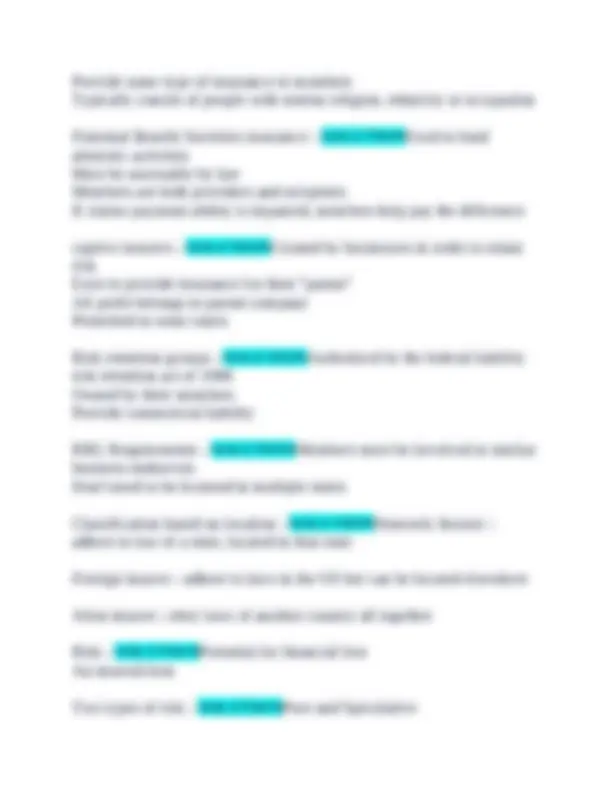
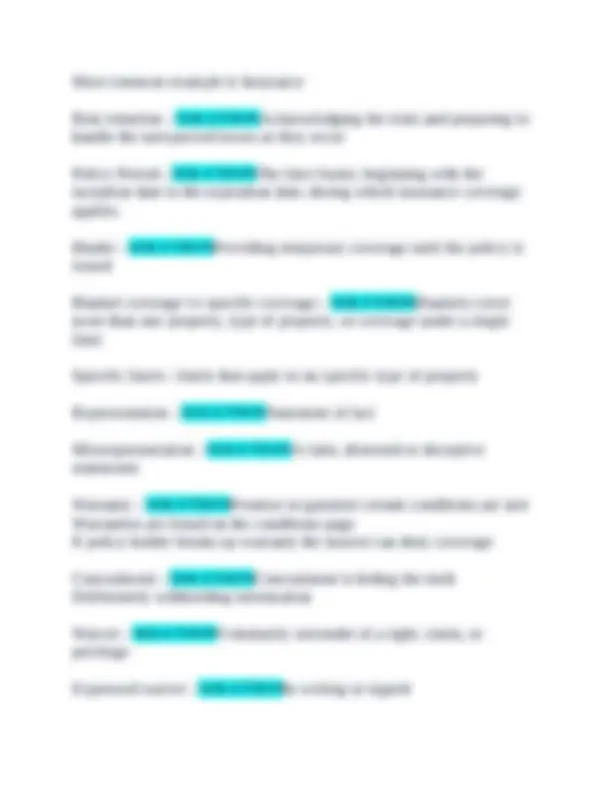
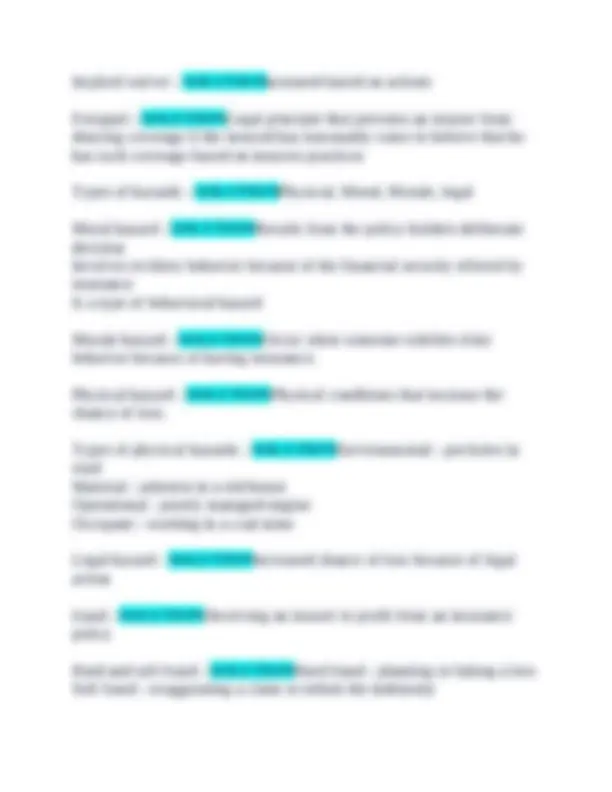
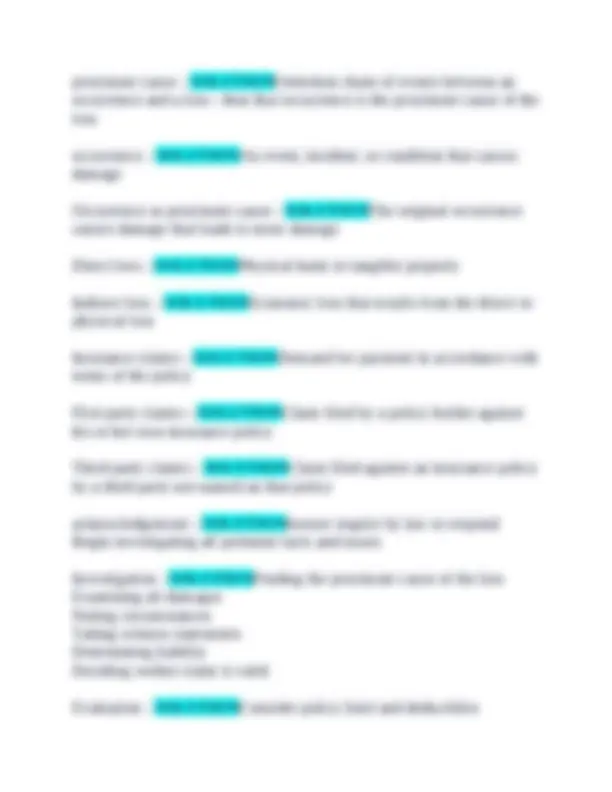
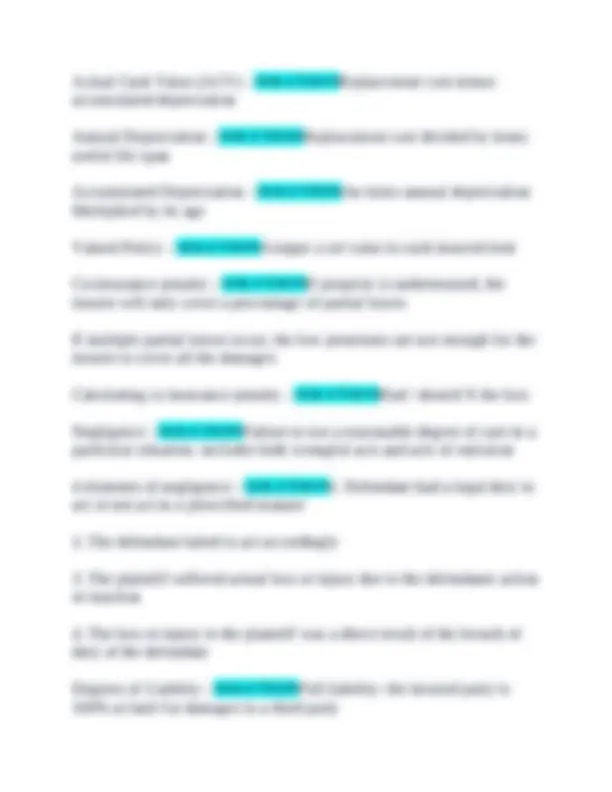
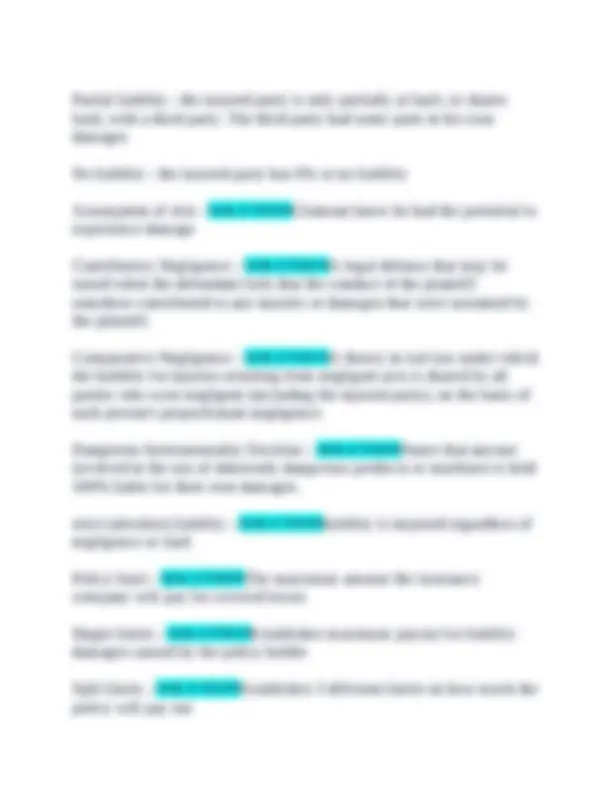
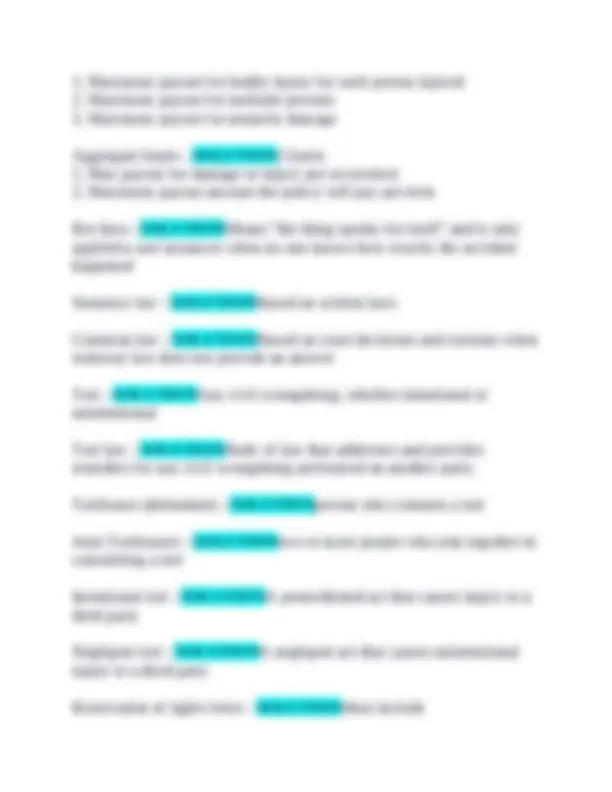
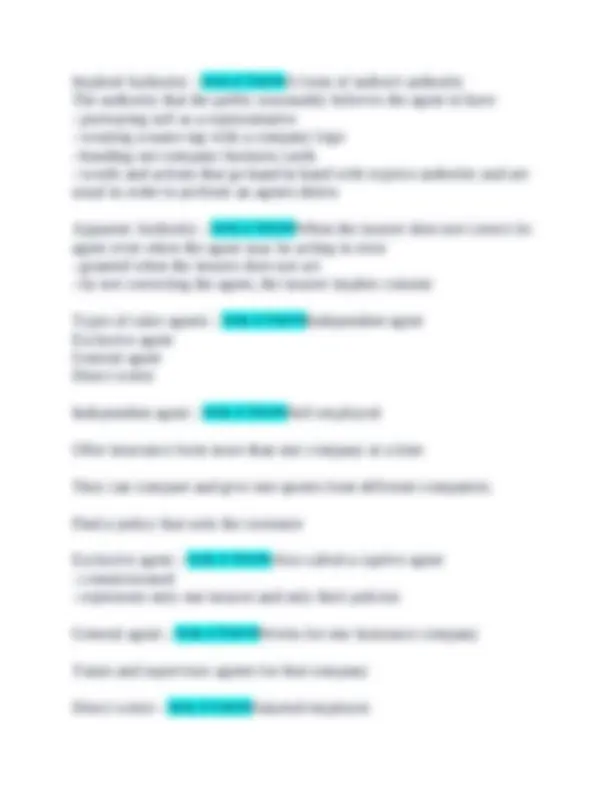



Study with the several resources on Docsity

Earn points by helping other students or get them with a premium plan


Prepare for your exams
Study with the several resources on Docsity

Earn points to download
Earn points by helping other students or get them with a premium plan
Community
Ask the community for help and clear up your study doubts
Discover the best universities in your country according to Docsity users
Free resources
Download our free guides on studying techniques, anxiety management strategies, and thesis advice from Docsity tutors
ADJUSTER PRO - INSURANCE ADJUSTER EXAM ADJUSTER PRO - INSURANCE ADJUSTER EXAM
Typology: Exams
1 / 19

This page cannot be seen from the preview
Don't miss anything!












What is insurance? - SOLUTION protection against financial loss what is a premium - SOLUTION a scheduled amount to be paid for an insurance policy? What are premiums used for - SOLUTION premiums are collected into a "pool" or "reserve to pay out claimants when needed. how can insurance companies afford to pay for an individual’s catastrophic loss? - SOLUTION the insurer collects premiums from all policy holders and uses them to pay out the claims of a few. what is Indemnity - SOLUTION payment for damages, that is not more or less than the amount caused by the damage. principle of indemnity - SOLUTION insurance will pay no more or less than the actual financial loss suffered indemnification may also include - SOLUTION repairs to property reimbursement for additional living expenses rental cars and hotels costs directly associated with a loss 4 Parts of Legal Contract - SOLUTION 1. Agreement
six special characteristics of insurance contracts - SOLUTION 1. Personal
Characteristics of social insurance - SOLUTION Non profit Mandatory participation Benefits prescribed by law Designed to meet needs of public Government has monopoly Private Insurers - SOLUTION Sell insurance based on needs and preferences Wide variety of products Exist to generate a profit Insured party voluntarily participate Stock Insurance Companies - SOLUTION Always for profit Publicly traded Stockholder provide capital and participate in profit or losses "Non participation" insurers - no dividends go to policy holders Mutual Insurance Company - SOLUTION No shareholders Policy holders elect board of directors "Participating" insurers - policy holders participate in dividends Re-insurer - SOLUTION Provides insurance for insurers to reduce exposure to loss Pays percentage of insurers loss or any loss over a certain amount Reciprocal Insurers - SOLUTION Unincorporated Non profit Operated by attorney in fact Members pay into individual accounts Cost of claims shared by whole groups Fraternal Benefit Societies - SOLUTION Also called fraternal associations Non profit mutual aid organizations Engage in charitable activities
Provide some type of insurance to members Typically consist of people with similar religion, ethnicity or occupation Fraternal Benefit Societies insurance - SOLUTION Used to fund altruistic activities Must be assessable by law Members are both providers and recipients If claims payment ability is impaired, members help pay the difference captive insurers - SOLUTION Created by businesses in order to retain risk Exist to provide insurance for their "parent" All profit belongs to parent company Permitted in some states Risk retention groups - SOLUTION Authorized by the federal liability risk retention act of 1986 Owned by their members Provide commercial liability RRG Requirements - SOLUTION Members must be involved in similar business endeavors Don't need to be licensed in multiple states Classification based on location - SOLUTION Domestic Insurer - adhere to law of a state, located in that state Foreign insurer - adhere to laws in the US but can be located elsewhere Alien insurer - obey laws of another country all together Risk - SOLUTION Potential for financial loss An insured item Two types of risk - SOLUTION Pure and Speculative
Item has precise value Unexpected loss - SOLUTION Unforeseeable Unexpected Reasonably unpreventable Random in nature Substantial loss - SOLUTION Must cause substantial economic hardship Exclusions - SOLUTION Insurer must be able to exclude large scale disasters and catastrophic events Law of large numbers - SOLUTION Insurer must be able to cover large numbers of similar risks Spreads risk across more policies Helps insurers predict losses more accurately Similar risks can mean, cars houses, persons lives, similar business etc Adverse Selection - SOLUTION when someone buys health insurance because they know they will probably file a claim 4 risk management techniques - SOLUTION Avoidance Reduction Transference Retention Risk avoidance - SOLUTION Eliminates risk by not taking action that involves risk Risk reduction - SOLUTION Taking measures to reduce risk that is involved Also called risk mitigation Risk Transference - SOLUTION Management of sever risk by transferring risk to someone else
Most common example is Insurance Risk retention - SOLUTION Acknowledging the risks and preparing to handle the unexpected losses as they occur Policy Period - SOLUTION The time frame, beginning with the inception date to the expiration date, during which insurance coverage applies. Binder - SOLUTION Providing temporary coverage until the policy is issued Blanket coverage vs specific coverage - SOLUTION Blankets cover more than one property, type of property, or coverage under a single limit Specific limits - limits that apply to on specific type of property Representation - SOLUTION Statement of fact Missrepresentation - SOLUTION A false, distorted or deceptive statements Warranty - SOLUTION Promise or garuntee certain conditions are met Warranties are found on the conditions page If policy holder breaks up warranty the insurer can deny coverage Concealment - SOLUTION Concealment is hiding the truth Deliberately withholding information Waiver - SOLUTION Voluntarily surrender of a right, claim, or privilege Expressed waiver - SOLUTION In writing or signed
proximate cause - SOLUTION Unbroken chain of events between an occurrence and a loss - then that occurrence is the proximate cause of the loss occurrence - SOLUTION An event, incident, or condition that causes damage Occurrence as proximate cause - SOLUTION The original occurrence causes damage that leads to more damage Direct loss - SOLUTION Physical harm to tangible property Indirect loss - SOLUTION Economic loss that results from the direct or physical loss Insurance claims - SOLUTION Demand for payment in accordance with terms of the policy First party claims - SOLUTION Claim filed by a policy holder against his or her own insurance policy Third party claims - SOLUTION Claim filed against an insurance policy by a third party not named on that policy acknowledgement - SOLUTION Insurer require by law to respond Begin investigating all pertinent facts and issues Investigation - SOLUTION Finding the proximate cause of the loss Examining all damages Noting circumstances Taking witness statements Determining liability Deciding wether claim is valid Evaluation - SOLUTION Consider policy limit and deductibles
Calculating lender interest Determining the value of the loss Applying all financial provisions of the policy Adjustment - SOLUTION If a claim is accepted, the insurer must pay promptly after notifying that the claim will be paid If claim is denied the insurer must explicitly state reasons for denial Insurable Interest - SOLUTION Only parties with insurable interest can insure a property or person You can only insure something that has some financial interest to you Lender interest - SOLUTION A lenders financial stake in an insured item Lender Interest Provisions - SOLUTION Allow the lender to be listed as a payee on the policy Endure the lender is notified if the policy is canceled, reduced, or expires Provide compensation for the lender in the event of an act or an omission by insurer party Permit lender to pay premiums to maintain coverage Limits on lender provisions - SOLUTION Lender may only collect up to its financial interest in a property Lender may never change or cancel an insurance policy Actual Cash Value - SOLUTION Same as fair market value and depreciation value ACV offers lower premiums for less coverage Formula: replacement cost minus depreciation
Actual Cash Value (ACV) - SOLUTION Replacement cost minus accumulated depreciation Annual Depreciation - SOLUTION Replacement cost divided by items useful life span Accumulated Depreciation - SOLUTION An items annual depreciation Multiplied by its age Valued Policy - SOLUTION Assigns a set value to each insured item Co-insurance penalty - SOLUTION If property is underinsured, the insurer will only cover a percentage of partial losses If multiple partial losses occur, the low premiums are not enough for the insurer to cover all the damages Calculating co insurance penalty - SOLUTION Had / should X the loss Negligence - SOLUTION Failure to use a reasonable degree of care in a particular situation- includes both wrongful acts and acts of omission 4 elements of negligence - SOLUTION 1. Defendant had a legal duty to act or not act in a prescribed manner
Partial liability - the insured party is only partially at fault, or shares fault, with a third party. The third party had some parts in his own damages No liability - the insured party has 0% or no liability Assumption of risk - SOLUTION Claimant knew he had the potential to experience damage Contributory Negligence - SOLUTION A legal defense that may be raised when the defendant feels that the conduct of the plaintiff somehow contributed to any injuries or damages that were sustained by the plaintiff. Comparative Negligence - SOLUTION A theory in tort law under which the liability for injuries resulting from negligent acts is shared by all parties who were negligent (including the injured party), on the basis of each person's proportionate negligence. Dangerous Instrumentality Doctrine - SOLUTION States that anyone involved in the use of inherently dangerous products or machines is held 100% liable for their own damages. strict (absolute) liability - SOLUTION liability is imposed regardless of negligence or fault Policy limit - SOLUTION The maximum amount the insurance company will pay for covered losses Single limits - SOLUTION Establishes maximum payout for liability damages caused by the policy holder Split limits - SOLUTION Establishes 3 different limits on how much the policy will pay out
Breach of product warranty - SOLUTION If a product is not suitable for its intended purpose and causes injury or damage. Waiver of Sovereign Immunity - SOLUTION Allows individuals to sue gov entities in certain cases Agent - SOLUTION One who receives the authority to act on behalf of someone else Sales agent - SOLUTION Contracted to sell and service insurance policies on behalf of the insurer Adjusters - SOLUTION Contracted to settle claims that arise against the insurer Power to bind - SOLUTION What the agent says or does can bind the insurer Agents should take the utmost care in what they say and do Even if the agent makes mistakes, the insurer may have to accept them Responsibilities of an agent - SOLUTION Adhere to or follow the contract Use reasonable judgement Provide all necessary information and documentation to the insurer Three types of authority - SOLUTION express, implied, apparent Express Authority - SOLUTION Authority directly granted to an agent via the contract -sell polices -collect premiums -issue binders
Works for one company